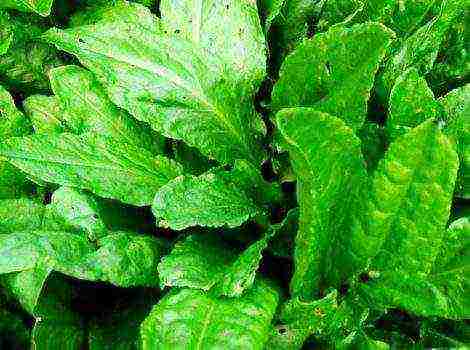Content
- 1 Briefly about kerry
- 2 Planting kerriya japonica
- 3 Kerria: care
- 4 Reproduction of Japanese kerria
- 5 Diseases and pests
- 6 Forms and varieties of kerrias
- 7 Kerria for penumbra: planting and care
- 8 Description of Japanese kerria and a photo of a bush
- 9 Varieties of Japanese kerriya for the Moscow region (with photo)
- 10 Reproduction, planting and caring for shrubs in the Moscow region
- 11 Landscaping: pruning and crown shaping
Briefly about kerry
Kerria japonica (Kerria japonica) is an openwork deciduous shrub about 2 meters high. In the Moscow region, kerria blooms in May, even before the foliage appears, and blooms for a very long time: up to 25 days. Moreover: in the fall, kerria pleases with repeated flowering, and individual flowers appear throughout the summer. Even non-flowering shrubs are very decorative in summer due to the graceful shape and rich greenery of the leaves, and in autumn due to their bright color. Yellow-green shoots of kerria will also decorate the winter garden, vividly contrasting with the whiteness of the snow. However, the winter hardiness of kerry is not particularly high, so it is still advisable to cover it for the winter. Although the frozen shoots recover quickly, the frost-affected plant does not bloom well.
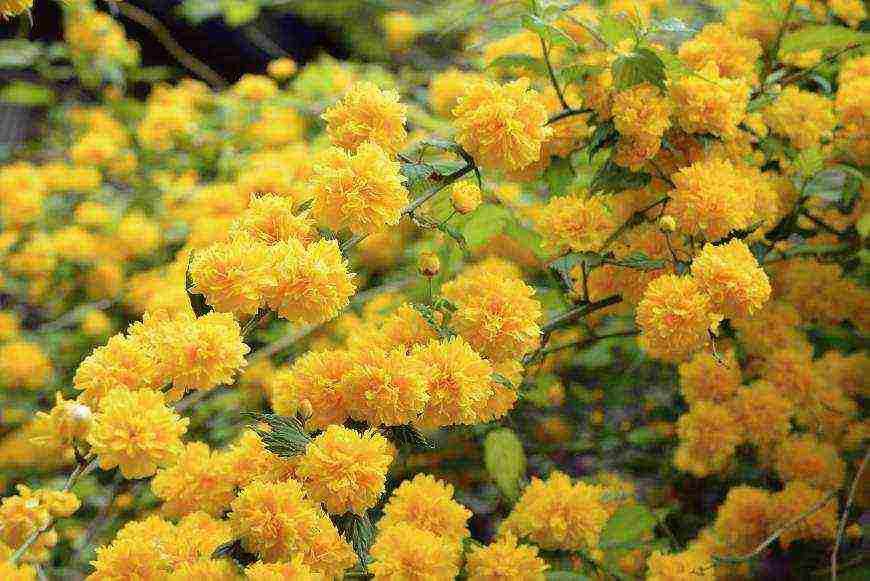
Planting kerriya japonica
The best place for kerrias is well-lit, sheltered from the cold winds. The plant feels good in partial shade, but with strong shading, the flowering will be more than modest. However, with constant exposure to direct sun, the flowers "fade", acquiring pale, whitish tips of the petals.
Kerria requires fertile, moist soil, preferably loamy.
The plant is planted in early spring, before the buds appear. An autumn planting is also possible - a month and a half before the cold weather. A bucket of compost mixed with garden soil, a glass of ash and 60-80 g of complete mineral fertilizer are introduced into a planting pit 60x60 cm in size. It is advisable not to deepen the root collar. After planting, the plant is watered abundantly, the trunk circle is mulched.
Kerria's shoots are thin and can break in strong winds, so it makes sense to plant it in the background, surrounded by other flowering shrubs, for example, yellow-leaved spirits, Kuril tea, bladders, which will take over from it and bloom later. In May, blue aquilegia, late double tulips and dwarf irises of purple tones, styloid phlox rugs and curtains of blue phlox spread out will look good against its background. Nearby, you can plant a buzulnik, which will overlap with the autumn flowering of kerrias. It goes well with conifers.

Kerria: care
Watering... The plant is hygrophilous, but does not tolerate excessive moisture, so watering should be abundant, especially during the flowering period and in the heat, but without stagnation of moisture in the soil.
Top dressing... Kerria Japanese is responsive to fertilization. In July, after flowering, it is fed with mullein infusion, if necessary, feeding is repeated after two weeks. The mullein can be replaced with matured compost with the addition of ash (100-200 g per sq. M.).
Pruning kerries are a prerequisite for preserving decorativeness. Frozen, damaged, broken branches are cut out in early spring. The remaining shoots can be shortened by a third - this stimulates branching. After flowering, faded shoots are cut out to branches on which there were no flowers - it is on them that buds will form for re-flowering in the fall. At the same time, rejuvenating pruning is carried out, removing all branches older than 4-5 years. With a strong thickening, the shrub is thinned out. Kerria Japanese grows quickly, so pruning is extremely useful for her.
Preparing for winter... With the onset of stable cold weather (in October-November), kerrias are sheltered for the winter. This should be done in dry weather.The bushes are carefully bent to the ground, laid on a dry bedding (for example, foam) and fixed with a frame made of stakes, which not only holds flexible branches, but also prevents snow from breaking them. Top covered with dry leaves or shavings and covered with a double layer of lutrasil. The shelter must be dry and ventilated, otherwise the bushes are threatened with damping. In the spring, the shelter is removed in stages, preferably in cloudy weather, after waiting for the end of return frosts. It is impossible to open kerria immediately: the delicate skin of young shoots quickly gets sunburn.
Kerria, affected by frost, is recovering quite quickly, but you should not expect abundant flowering this year.
Variegated forms of kerria (Picta, Albomarginate) are more demanding in terms of care and growing conditions.
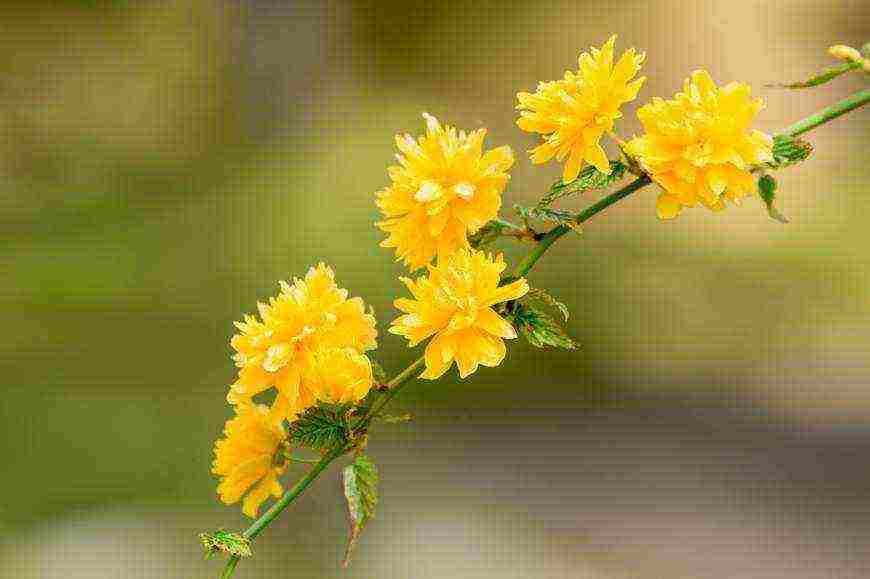
Reproduction of Japanese kerria
Kerria is propagated mainly by cuttings, which take root quite easily. Reproduction by offspring and layering is also possible.
Diseases and pests
Kerria is rarely affected by pests; with sufficient care, it is not susceptible to disease.
Forms and varieties of kerrias
The natural form of kerria has simple flowers, cultivars with spectacular double flowers, similar to small roses or dissected rudbeckia flowers ("Golden balls"), have been bred.
The most common garden varieties:
Pleniflora (Kerria Pleniflora, Plena) is a dense, upright shrub with abundant medium-sized (up to 3 cm) double flowers, similar to pompons.
Golden Guinea (Kerria Golden Guinea) is a shrub with graceful leaves and simple five-petal flowers of large size - up to 6 cm in diameter.
Variegata or Picta (Kerria Variegata, also known as Kerria Picta) - with simple five-petal flowers and very decorative gray-green leaves with a cream border.
Albomarginata (Kerria Albomarginata) - with simple flowers and graceful leaves with a white border.
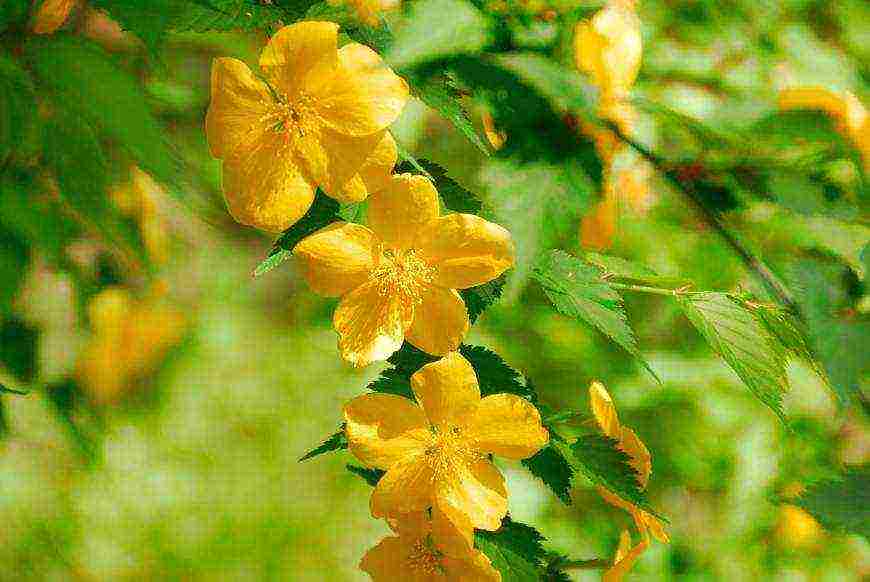
CARE RECOMMENDATIONS
Requires shelter for the winter.
Grows well in fertile, moist loamy soil.
Shade tolerant, but needs bright light for abundant flowering.
Watering is plentiful, but not excessive.
Cropping is required.
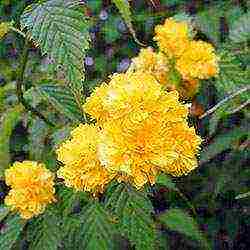 Kerria yellow is a plant that is rarely found in the vastness of our Motherland, despite its extraordinary decorativeness and bright lush flowering, and not only in the spring, but also in autumn. It is not difficult to grow kerria, the main thing is to remember some of the features of the plant and take them into account when taking care of the crop. Next, we will talk about the main varieties of the plant, planting and proper care for it in open ground (detailed photos of growing the plant are attached).
Kerria yellow is a plant that is rarely found in the vastness of our Motherland, despite its extraordinary decorativeness and bright lush flowering, and not only in the spring, but also in autumn. It is not difficult to grow kerria, the main thing is to remember some of the features of the plant and take them into account when taking care of the crop. Next, we will talk about the main varieties of the plant, planting and proper care for it in open ground (detailed photos of growing the plant are attached).
Description, main varieties and varieties
Kerria yellow (another name - Japanese) in natural conditions is found mainly in the mountainous regions of Japan and China. Europeans know the flower under the name "Easter rose" because of its external similarity and the beginning of flowering right before Easter. The plant is a fast-growing large shrub, reaching a height of 2-3 m, has straight rod-shaped stems that form a conical crown.
The leaves of the plant are very similar to crimson, strongly pubescent on the underside. The flowers grow singly, are distinguished by a delicate bright yellow color, reach 4-5 cm in diameter. The flowering of the plant is abundant, rather long - it is about a month (from May to August). With the onset of autumn, re-flowering occurs.
Although kerria is presented in only one form, there are a large number of different garden forms and varieties of this plant (you can familiarize yourself with them in the attached photo):
- Variegata. A fast-growing variegated kerria, reaching a height of about 0.6 m. The leaves are gray-green in color, covered with small cream-colored spots on top. The flowers are yellow and grow very quickly.
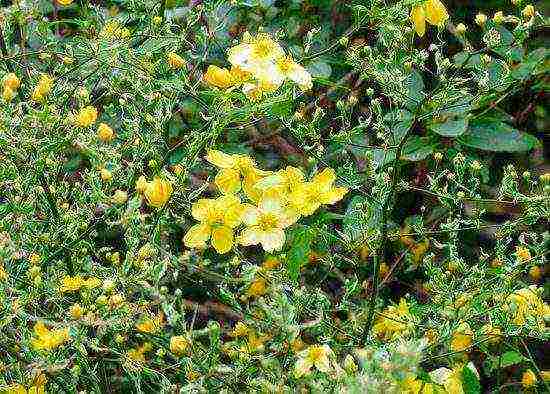
Variegata
- Albomarginata.Slow growing variety of kerria. The leaves of the plant are slightly asymmetric, and around the edges are as if surrounded by a white border. Due to such a specific external feature, the plant is often considered unviable, but in fact this is not the case.
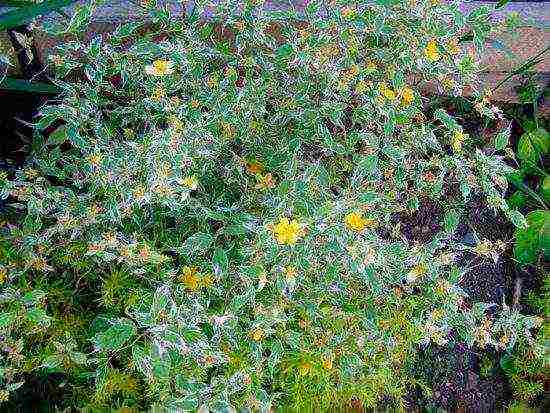
Albomarginata
- Kerria Japanese Aureovariyegata. Terry variety with flowers that have a rather complex structure. The shrub is medium in size and has a long flowering period: with proper care, flowers form within a few months.
- Kerria Golden Guinea. The plant is distinguished by graceful thin leaves and impressive flowers, reaching a diameter of 6 cm.

Kerria Golden Guinea
- Kerria Pleniflora. The original variety, during the flowering period, pleases with luxurious double pom-pom flowers.
Correct planting of culture
Most often, this process is carried out either in early spring or in autumn, 30-40 days before the onset of the first frost.
Advice. If you plan to plant seedlings with a closed root system, it can be done almost at any time of the year, except for winter.
When choosing a place for culture, an experienced gardener will prefer a dry, calm, sunny area. The plant will be able to survive, of course, in partial shade, but in this case it will be more difficult to achieve lush flowering. By the way, it is better to avoid places completely open to the sun: the plant can burn out.
The best option is considered to be areas with a light mesh shadow from tall trees with a lush crown.
Kerria is quite picky about the soil: it is better to choose fertile, sufficiently moist and nutritious soil for planting the plant (loam is ideal).
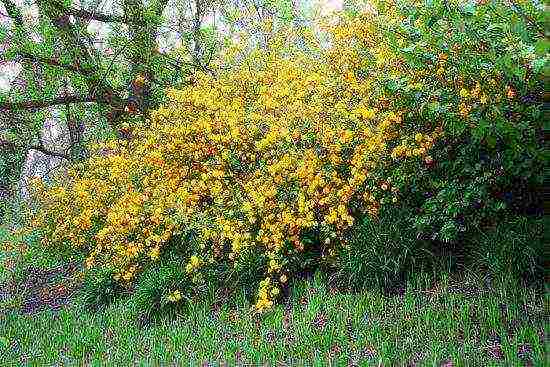
Kerria loves the shadow
The well for planting should have the following dimensions: 60x60 cm and a depth of about 0.5 m.A soil mixture is poured into the bottom of the pit, consisting of the soil itself, as well as turf and humus in a ratio of 2: 3: 3 (you can add a little complex fertilizer there - about 70 g).
A seedling is set on top of a hill of earth. The roots should be carefully straightened, after which the plant should be covered with the remaining soil mixture, lightly tamped on top and watered abundantly with water. The root collar should be practically on the soil surface.
Subtleties of care: feeding, watering, protection from pests
Kerria is an unpretentious plant that requires care solely for the purpose of maintaining a decorative appearance, and in order for it to be such, it is necessary to take care of a high level of health and grooming of the shrub. This can be achieved by following simple rules that will lead to the desired result.
In order for a plant to really grow healthy and beautiful, it is enough to follow a certain set of care measures:
- Watering. Kerria does not need abundant watering, it is enough to monitor the state of the upper soil layer: it should not dry out. Particular emphasis should be placed on soil moisture during dry periods and during the flowering of the plant. Water for irrigation must be warm and well-separated. During the period of frequent rains, it is advisable to reduce watering to a minimum.
- Loosening and weeding of the soil. After each watering, it is imperative to weed the area with growing kerry and thoroughly fluff the soil.

Kerrias need frequent feeding
- Top dressing. Kerria does not require a significant amount of fertilizer: it is enough to add mullein infusion (in a ratio of 1:10) or compost only after flowering.
- Pruning a plant. With the onset of the first days of spring, all dead, old broken branches are necessarily removed, and young ones are cut off by 1/4. As a result of such a preventive procedure, kerria will grow into a compact and at the same time very dense bush, and the flowering will be luxurious.
- Diseases and pests. Kerria is completely immune to both infections (of any type) and insect pests. At the moment, no recorded cases of the disease have yet been observed.
Plant propagation
Kerria propagation is carried out exclusively by vegetative methods:
- Cuttings. When a plant is propagated by cuttings, it is necessary to cut off only those branches on which 2 full-fledged buds have formed. The cut is done obliquely (usually in the middle of spring). The cuttings are initially planted in a closed, cold greenhouse. Rooting is rather slow, so the cuttings should be left in a greenhouse for the winter. And only by spring can they be planted in separate containers. In open ground, planting is carried out after a year.
- Layers. In early spring, young shoots of kerria fit into rather deep (about 7 cm) grooves and are fixed in this position. After a couple of weeks, new shoots begin to branch off from the buds of the cuttings. When they reach 15 cm in height, sprinkle the shoots up to half with earth and wait for the plants to take root (this usually happens in autumn). During this period, you can separate the layers and replant them.
- By dividing the bush. When propagating a plant by division, it is important to keep the bush intact at the time of digging out of the ground and thoroughly clean its roots from the ground. The bush should be divided in such a way that each of its parts has a fully developed root and strong shoots. Parts of the bush are planted in holes, carefully covered with earth and watered abundantly.
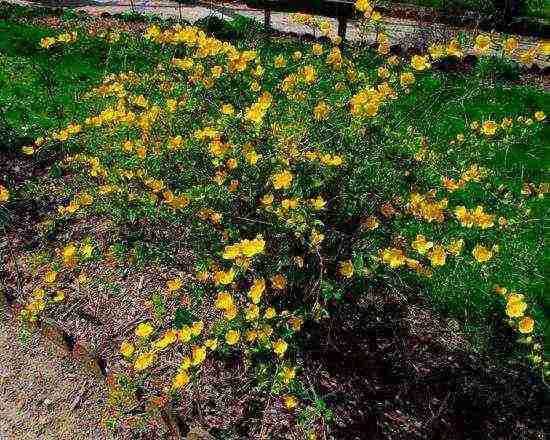
Kerria looks great in the garden
The combination of yellow kerrias with other plants
Most often, kerria is used either as a hedge or in close proximity with other plants when creating mixborders. The plant looks great in combination with spring primroses (rhododendron, mahonia, etc.).
Kerria branches often break from gusts of wind, so as protection against possible unpleasant consequences, plant it next to powerful flowering shrubs such as bladderwort or spiraea.
Also, next to the kerria, you can plant luxurious irises, a wonderful buzulnik, which will perfectly harmonize with kerria in the fall during its re-flowering period.
This concludes the consideration of the features of growing yellow kerrias in the open field. Now you know about all the intricacies of caring for this beautiful flower. Good luck!
Kerria: video
Kerria for penumbra: planting and care
 The ornamental shrub of kerria looks unusual on the personal plot. Outwardly, before the flowering period, it resembles an ordinary garden raspberry, but during the flowering period, bright yellow flowers against the background of still leafless branches look very impressive. The people call kerria an Easter or Japanese rose. It fits very harmoniously into a Japanese-style garden.
The ornamental shrub of kerria looks unusual on the personal plot. Outwardly, before the flowering period, it resembles an ordinary garden raspberry, but during the flowering period, bright yellow flowers against the background of still leafless branches look very impressive. The people call kerria an Easter or Japanese rose. It fits very harmoniously into a Japanese-style garden.
Kerria is an unusual deciduous shrub, it has green-yellow shoots, and its leaves are serrated, elongated. Flowering begins in early spring and lasts until summer, i.e. at a time when everything still looks dull and dull, such beauty will already bloom on your personal plot. The aroma of kerria is unobtrusive, very subtle.
In landscape design, kerrias are planted near the lawn, it looks organically against the background of the Moorish lawn, behind the mixborders. Perfectly relates to a number of growing primroses, mahonia, rhododendrons, weigels, forsythia and other plants. With the natural style of the personal plot, kerria is combined with geyhera, badan, hazel grouse.
It is not difficult to grow kerria in the garden, the main thing is to have the necessary information on the peculiarities of planting and care.
Place and soil
The ornamental kerria shrub feels great in partial shade! If it is planted in a place open to the sun, then it will be necessary to constantly monitor the moisture of the soil, while the color of the flowers will be pale. It is advisable to protect the landing site from the winds. The soil prefers moist, organic-rich, permeable.
Landing
Kerrias are planted in early spring, before bud break or in early autumn, 30-50 days before the onset of frost.
Prepare a planting hole 40-50 cm deep, 60 cm in diameter. The distance from the kerria to any other plant should be at least 60-80 cm.Fill the hole with fertile soil (sod land, humus, a fertile layer of garden soil and 60 g of complex mineral fertilizer), form a hill and install a plant with an earthen clod. Water and mulch well.
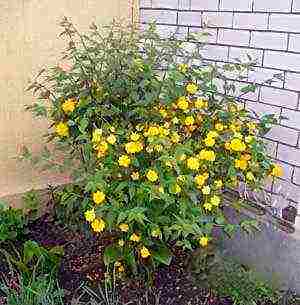
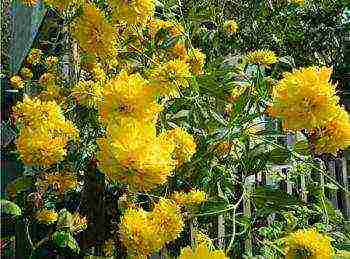
Care
During the first 2 weeks after planting, water kerrias abundantly.
Kerria is a very winter-hardy plant, practically not damaged by diseases and pests, but it is better to cover young plants in October-November with any dry shelter. First, the bush is loosely tied, set around the stakes, covered with dry leaves or sawdust, a film is put on the frame. In the spring, first, the leaves or sawdust are gradually removed, and then the film.
An obligatory procedure in the care of kerrias is pruning. In early spring, before the start of sap flow, cut off the broken branches. Every year after flowering, you need to cut the old branches at the age of 4-5 years to a stump for the growth of young ones, and simply shorten the young branches by a third. After pruning, top dressing is carried out with compost and wood ash (100-20 g per 1 square meter). Manure is not used as top dressing for kerrias.
Reproduction
Kerria is propagated by green cuttings or root suckers. It is very convenient to propagate kerria with shoots, since its shrubs form in large quantities. Reproduction is carried out in September or May. If the reproduction of kerria is not included in your plans, then the root shoots must be removed in a timely manner.
Hybrid tea roses can harbor other varieties
Summer watering of plants. Watering the garden
Mountain pine (gnome, pug, pumilio). Photo
Common evergreen vines in the garden
Description of shrubs: pyracantha, kerria, cinquefoil, mountain ash, fieldfare, plum, spirea, stephanander ...
Weigela planting, care and shelter for the winter
Rosehip breeding methods
The natural habitat of this shrub is in the highlands of Japan, and the culture is widespread in China. Kerria japonica belongs to the botinic rosaceous numerous family and occupies far from the last place there. The shrub has excellent aesthetic properties and is used in landscape design. Proper planting and caring for shrubs in the Moscow region allows you to maintain their external attractiveness for many years. All the intricacies of growing can be found in this article. Look at the photo of the varieties of Japanese kerriya ("Pleniflora", "Aureovarigata" and "Terry"):
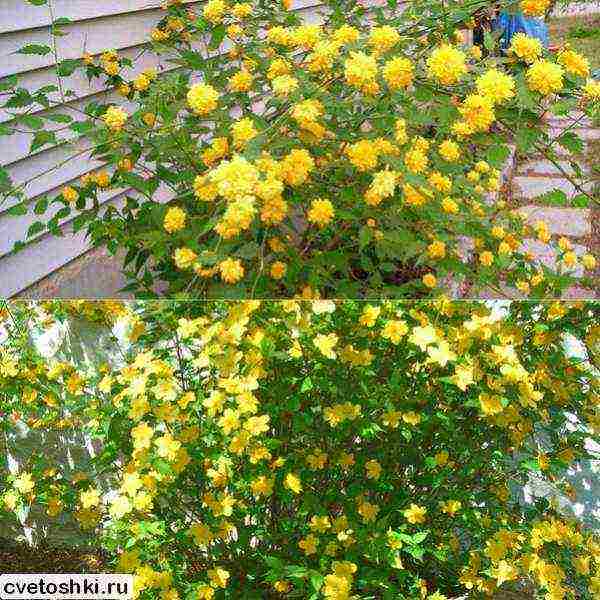
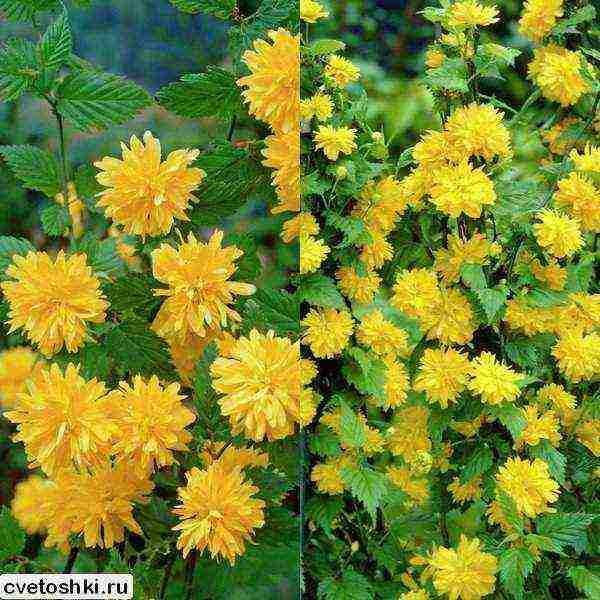

Description of Japanese kerria and a photo of a bush
It's worth starting with the fact that this is a plant with a shoot height of up to 2 meters. This circumstance should be taken into account when planning a landing site. The description of Japanese kerria has been proposed by several botanists, but basically it agrees on all points. At the initial stage of development, the shoots are long branches of green color without the formation of an integumentary bark. The root system is evenly distributed in the depth of the soil. It has the ability to quickly increase the number of shoots already in the first year after spring planting. Look at a photo of the Japanese kerria shrub in various ways of using it on a personal plot:


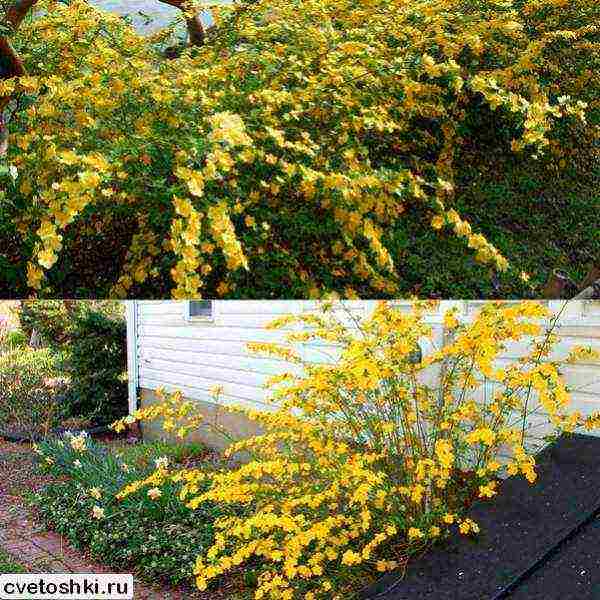
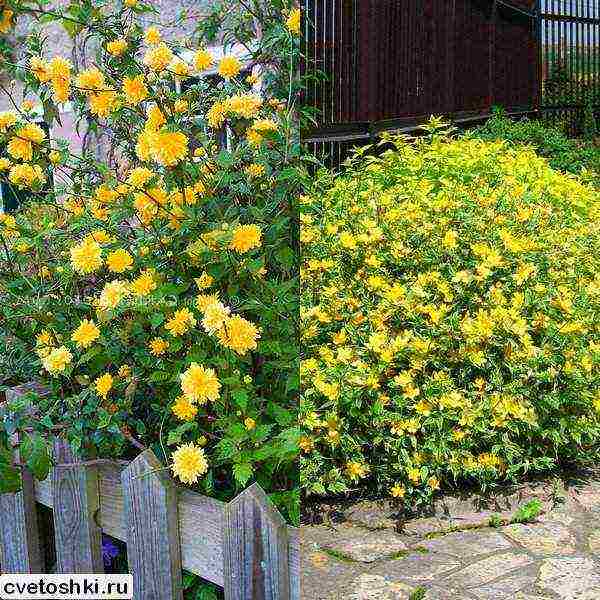
The lack of the ability to actively branch out forms a rather dense monotonous crown, which, with a high-quality haircut, remains throughout the season. The decorative value of a culture is its leaves and buds. Each leaf is slightly elongated and has a scalloped edge. The light green hue is replaced by rich orange and crimson tones closer to autumn. Duration of flowering is up to 2 months due to the continuous formation of new buds in the axillary buds of the shoots. Flowering begins in mid-June. The flower has a rose-like shape. The predominant color of the petals is yellow. The diameter of the blossoming bud is 60 mm.
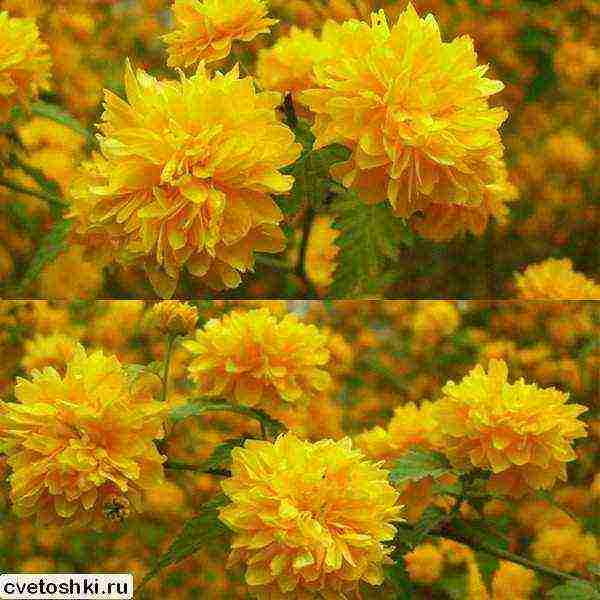

Varieties of Japanese kerriya for the Moscow region (with photo)
Growing any crop requires a careful approach to the selection of suitable species.Varieties of Japanese kerriya for the Moscow region are resistant to adverse environmental factors. They have the ability to endure rather harsh snowless winters. Even in the case of freezing of the ground part, it is enough to carry out spring pruning and by mid-July the shrub will fully restore its decorative value. Next, we will consider some varieties - descriptions and photos can be found on the page. Keria Japanese "Pleniflora" (Pleniflora) is distinguished by the greatest decorativeness in the process of its flowering. The height of the shrub is up to 2 meters with a crown girth diameter of up to 1.5 meters. The green, springy branches are decorated with curly leaves that turn into a rich yellow in autumn. Refers to deciduous forms. Requires a small shelter for the winter, for this, the branches, after the foliage is dropped, are bent to the ground and fixed in this position. From above, a shelter is carried out with coniferous spruce branches, straw or plastic bags. In spring, the shelter is removed immediately after the snow cover disappears. With the preservation of the entire mass of shoots after wintering in the conditions of the Moscow region, flowering begins in the 20th of May. The buds have a compact, rose-like shape, with a diameter of up to 5 cm. They are painted in bright yellow tones. Often, under favorable conditions, a repeated flowering wave is observed at the end of August.
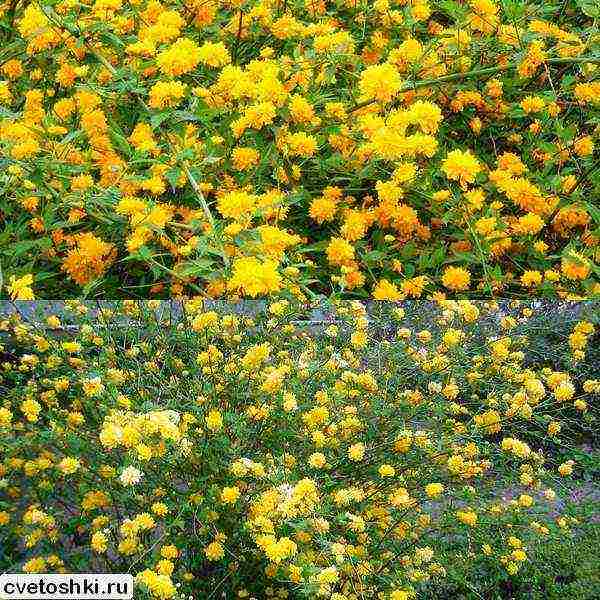
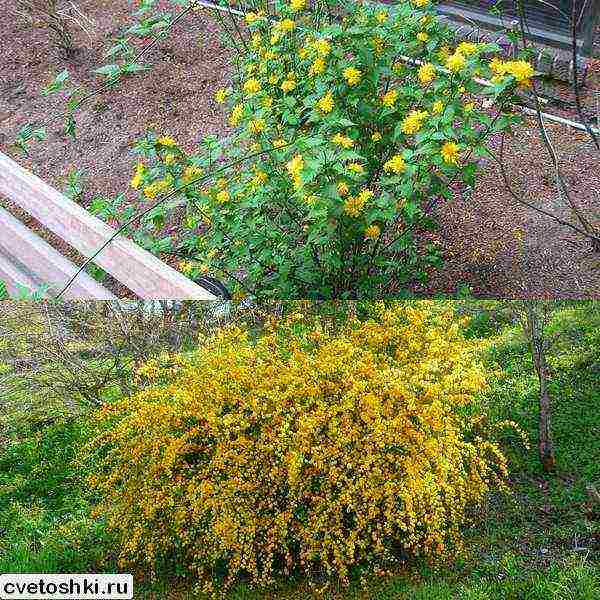
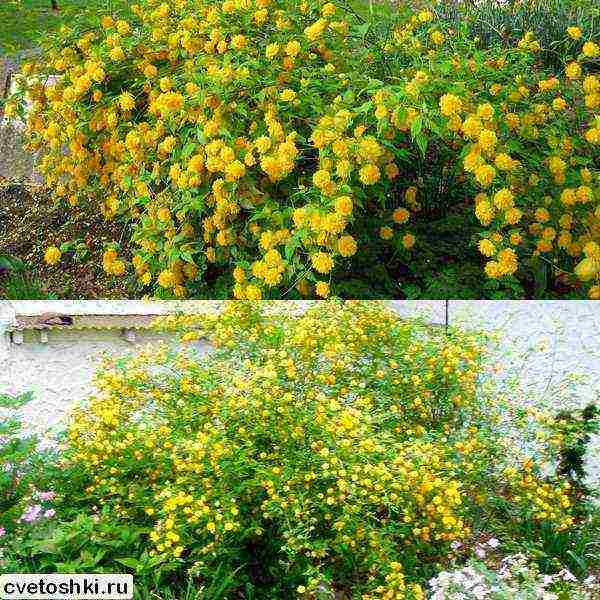
Kerria Japanese "Aureovarigata" is a terry variety with a complex bud structure. Differs in average bush growth and long flowering, reaching 3 months with proper care.
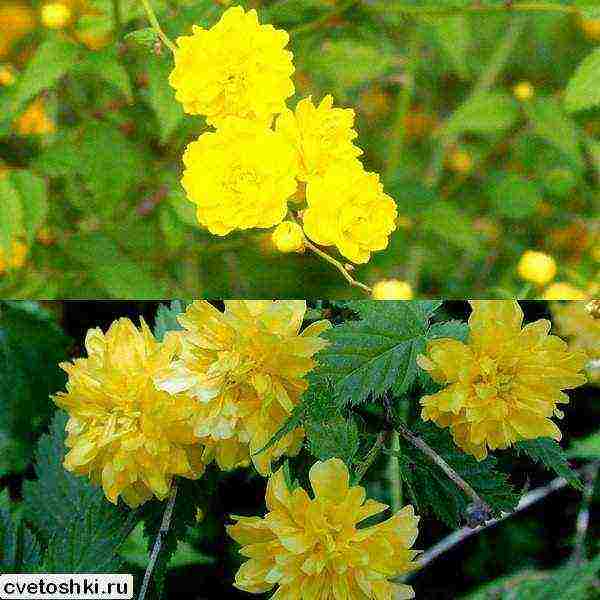
Among other varieties that deserve close attention, the dwarf form Variegata stands out, with a bush height of only 60 cm. It is suitable for decorating flower beds, rockeries and alpine slides. Looks great as a curb culture along garden paths. Simple buds with 5 bright yellow petals.

Crops with atypical colors of leaves and flowers are of particular value in landscape design. Japanese kerria "Albomarginata" belongs to such varieties. Its curly leaves with a rich green color are framed with a white stripe. By itself, this plant looks just great. And at the time of active flowering, it turns into a real yellow cloud due to the abundance of blossoming buds.

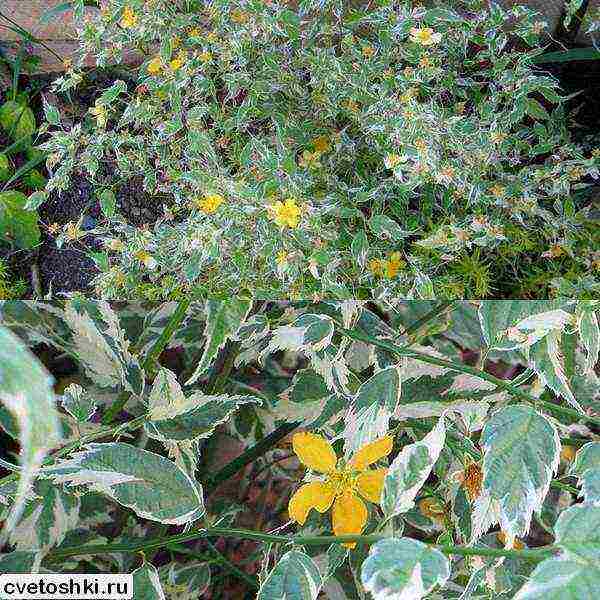
For lovers of exoticism, there will also be a valuable Japanese kerria "Albiflora", pleasing to the eye with a pleasant boiling whiteness of large double buds. Tall bushes up to 2 meters are decorated with densely planted curly foliage of dark green color. White flowers of complex and simple shape bloom on the shoots in large numbers. Looks attractive in group planting with other varieties of kerrias.
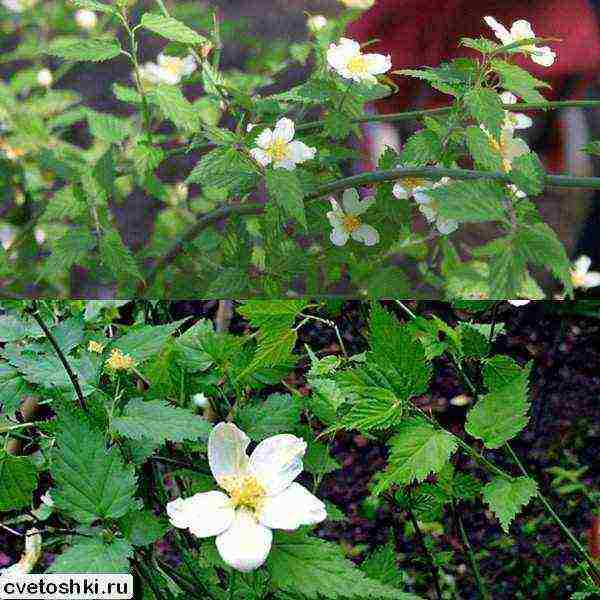
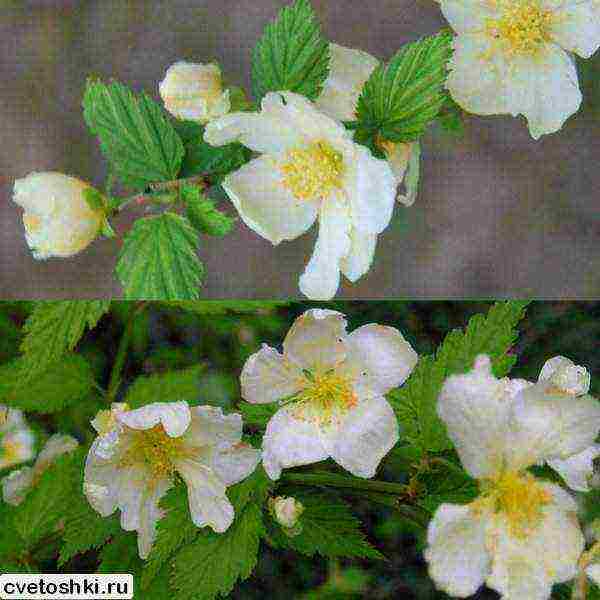
Reproduction, planting and caring for shrubs in the Moscow region
The culture is quite unpretentious. Reproduction is carried out mainly by cuttings during spring pruning of bushes. Rooting cuttings is not difficult even for novice gardeners. Correct planting and caring for shrubs in the Moscow region are presented in detail later in the article.
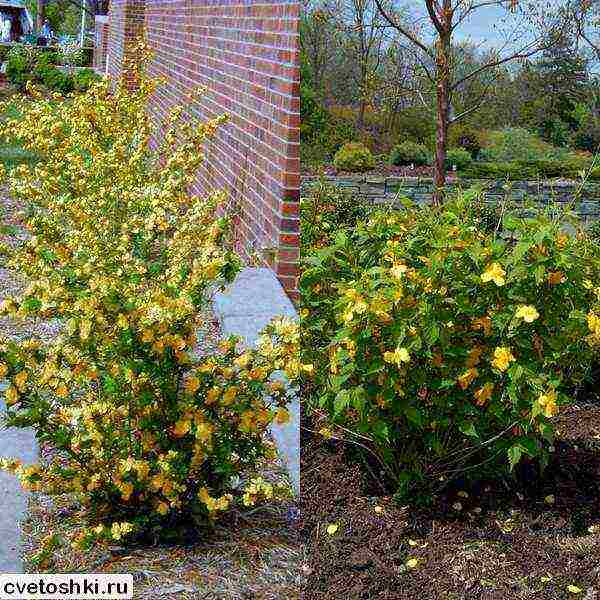

The main rule is the choice of a place for planting Japanese kerrias - the shrub prefers bright sunny places, without the influence of strong winds. In partial shade, it is possible to change the color of the foliage, strong elongation of the shoots. Due to this, decorative properties are lost. The soil should be sufficiently fertilized with organic and mineral substances. It is very important to dig a deep trench up to 1.5 meters deep before preparing the landing site. Broken brick or coarse gravel is laid on the bottom with a layer of up to 70 cm. Then a layer of organic humus up to 30 cm is laid. The remaining space is covered with planting soil. After that, the holes are prepared and the Japanese kerrias are planted with grown and rooted cuttings. Proper care of Japanese kerrias includes regular watering (the soil should not dry out to a depth of 10 cm).Mineral fertilizing with special preparations for ornamental and flowering crops is carried out every week. They are added to the water for irrigation. For reproduction, you should take apical shoots up to 6 cm long. They are cut with a sharp pruner and placed in water with the addition of succinic acid tablets. This drug is diluted at the rate of 4 tablets per 1 liter of water, stimulates the formation of the root system. After the appearance of small roots, the cuttings go deeper into the ground on a separate school. From above, they can be covered with small makeshift greenhouses. In the fall, you will get ready-made seedlings. But they should be planted in a permanent place only in the spring.
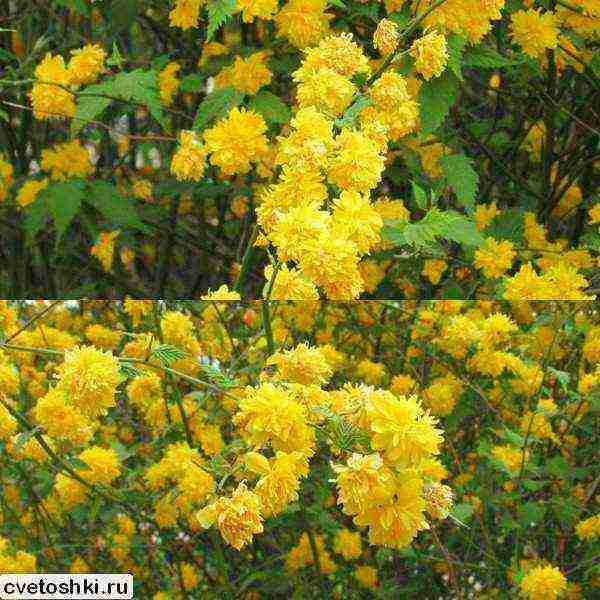
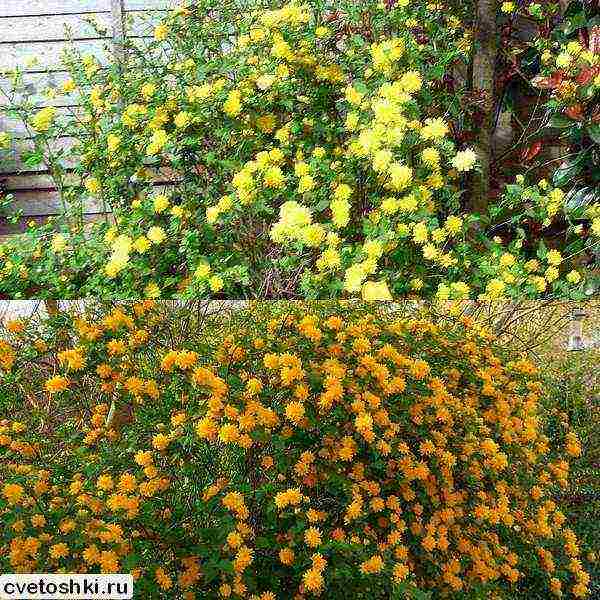
Landscaping: pruning and crown shaping
Landscaping is an established area of application for Japanese kerrias as an ornamental culture. But only by organizing the proper care of the shrub, you can get a great appearance of the culture. Not the last place in this process is taken by pruning and forming the correct crown.
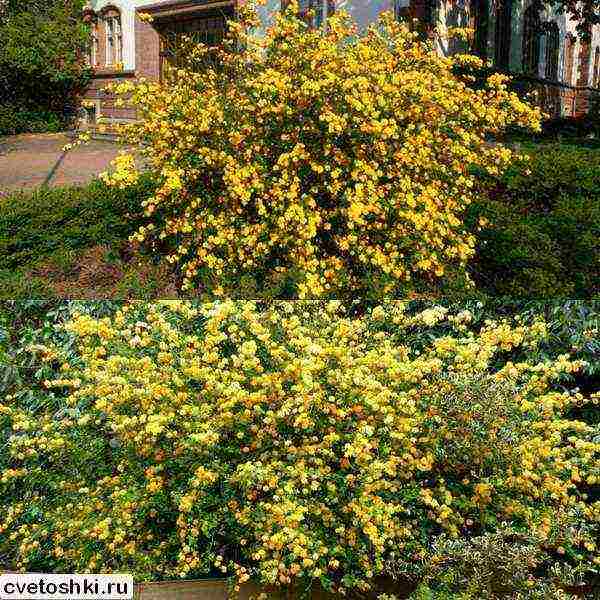
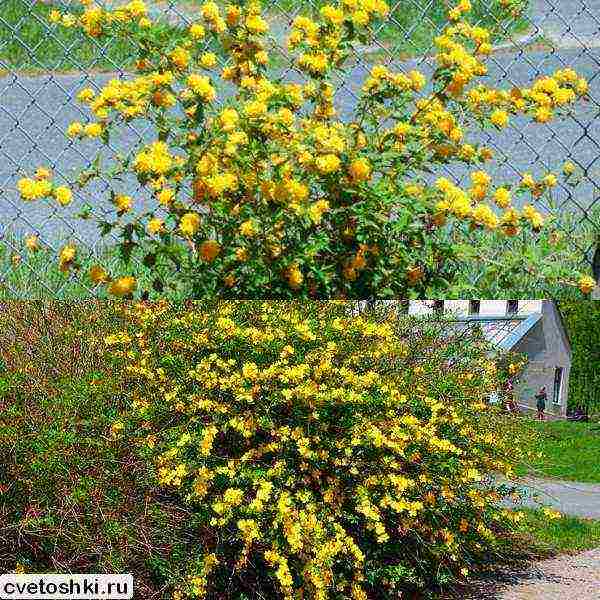
The rules for the spring skim of the Japanese kerria include the following aspects:
- the first revision should be carried out immediately after the snow melts;
- the shelter is removed, all damaged and dry shoots are removed, they can become a breeding ground for pathogenic microorganisms and parasites;
- the second are those branches that thicken the bush and interfere with the proper development of the culture;
- the last stage is pruning all the remaining branches, without exception, by ¼ of their length.
Young bushes in the second year of life are cut completely at a height of 15 - 2 cm from the ground. This is how a rich crown of the correct shape is formed due to the formation of lateral branches. In landscape design, kerriya japonica is used primarily as a background crop for the horizontal spectrum of landscaping. Both single and group landings look great. The shrub can be grown along fences and facades, on alpine slides, along garden and park paths. The formation of compositions with various coniferous crops is widely used.
